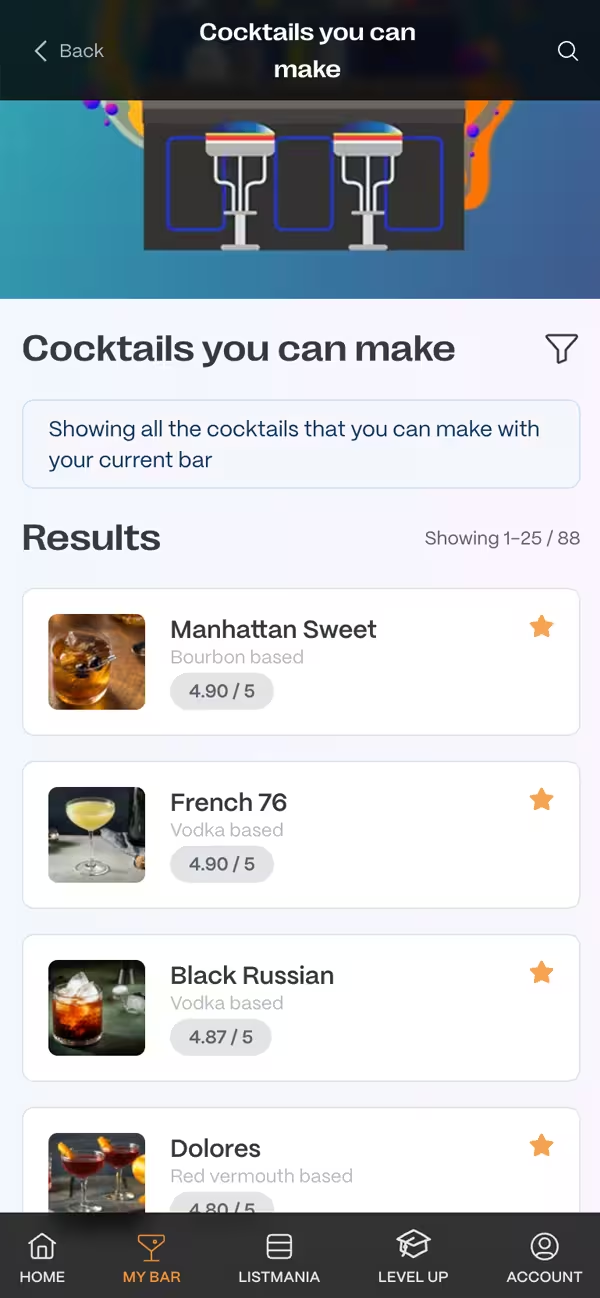History of the Sazerac Cocktail
Jump to
- TL;DR
- The Origins of the Sazerac: A Cocktail Born in New Orleans
- Overcoming Troubled Times
- The Sazerac: Symbol of Louisiana
- Crafting the Perfect Sazerac
An intoxicating combination of absinthe, cognac, and bitters, with a teaspoon of sugar for good measure, the Sazerac is not a cocktail that should be gulped down quickly. The high alcohol content demands that you sip it slowly, savoring every last drop - drink too fast and you might not make it to your second!
TL;DR
- The Sazerac cocktail originated in 1830s New Orleans, crafted by Antoine Amédée Peychaud using his own Peychaud's Bitters.
- The drink evolved from cognac to rye whiskey due to the phylloxera epidemic in the late 19th century.
- An absinthe ban from 1912 to 2007 led to the use of substitute liqueurs until the ban was lifted.
- Named the official cocktail of Louisiana in 2008, the Sazerac symbolizes New Orleans' rich cultural heritage.
The Origins of the Sazerac: A Cocktail Born in New Orleans
The Sazerac is a cocktail deeply entwined with the rich tapestry of New Orleans history. The key ingredient of a true Sazerac is Peychaud's Bitters - any other bitters simply won't do if you want the most authentic experience. But why is that? The reason lies in its origins, where both the bitters and the cocktail were invented by one remarkable man: Antoine Amédée Peychaud.
Back in the 1830s, Peychaud was the owner of a pharmacy in the bustling city of New Orleans. Like many pharmacists of his time, he created his own proprietary “tonic” – which in this case was the now-famous Peychaud's Bitters. He began mixing his bitters with Sazerac de Forge et Fils cognac, and a bit of sugar to create a concoction he believed had medicinal properties. Peychaud would serve this warming blend to customers, who quickly developed a taste for the invigorating drink. It wasn't long before its popularity began to grow beyond the walls of Peychaud's pharmacy.
Originally served in a small egg cup, known in French as a “coquetier”, Peychaud’s invention started being recognized as a delightful drink rather than just a medicinal remedy. Its success caught the attention of a local coffee house, which secured the rights to sell the cocktail and named it after the brand of cognac used in its creation.
In time, the cognac was substituted for rye whiskey, a change that came about partly due to the shortage of French cognac following the phylloxera epidemic in the late 19th century. Thus, the drink evolved into the Sazerac we know and love today.
Overcoming Troubled Times
However, the journey of the Sazerac has not always been a smooth one. In 1912, the cocktail faced a significant challenge when absinthe was banned in the United States and many parts of Europe. The ban was due to the presence of thujone, a chemical that was believed, albeit erroneously, to have harmful psychoactive effects, including hallucinations and seizures.
During the years of absinthe's absence, bartenders substituted the green spirit with various anise-flavored liqueurs like Herbsaint – a New Orleans-born brand specifically developed as an absinthe substitute. While the Sazerac remained popular, many aficionados felt it lacked the unique character imparted by genuine absinthe.
Relief arrived in 2007 when the United States lifted the absinthe ban after it was determined that the modern production levels of thujone were too low to cause any adverse effects. This meant that bartenders could again craft Sazeracs in their original glory, reigniting interest in this historic cocktail. This change was met with enthusiasm in the cocktail community and beyond.
Pardon the interruption
Did you know that you can become a member for free, taking your cocktail making skills up to level 11. You can save your My Bar ingredients, make tasting notes, have personalised Tried and Want to try lists and more.
The Sazerac: Symbol of Louisiana
With the return of absinthe, the Sazerac quickly re-established itself as a quintessential New Orleans cocktail. In recognition of its historical significance and deep cultural roots, the Sazerac was named the official cocktail of Louisiana in 2008. This designation only solidified its status as an essential part of the state's heritage and an indispensable experience for visitors to New Orleans.
As tourists flock to New Orleans, many make a point to savor a Sazerac at one of the city's iconic bars. It's more than just a drink; it's a sip of history, encapsulating the spirit and resilience of the Crescent City. From its humble beginnings in a local pharmacy to its recognition as a symbol of Louisiana, the Sazerac cocktail stands as a testament to the rich, layered history of New Orleans.
Lowball / rocks glass
Microbadges
<p>The Sazerac is a classic cocktail with a deep rooted history tied to New Orleans, often claimed to be America's first cocktail. This sophisticated drink is renowned for its distinctive combination of flavors: the herbal and anise notes of absinthe, the rich warmth of cognac, and the light spice of Peychaud's bitters.</p><p>Traditionally served in a lowball glass, the Sazerac presents a complex and aromatic profile with a touch of sweetness, typically garnished with a twist of lemon peel to add a citrusy fragrance. It's a cocktail that carries the mystique of Southern elegance and a legacy of cocktail craftsmanship.</p>
Ingredients
Method
How to make a Sazerac
-
- Take a chilled lowball glass and swirl the absinthe around the sides to coat the glass, and fill with ice
-
- In a mixing glass muddle the bitters and sugar, then add the cognac and stir to combine
-
- Disgard the ice and excess liquid from the glass and pour in the mixed drink
-
- Garnish with a lemon peel and serve
Crafting the Perfect Sazerac
Creating a perfect Sazerac is as much about technique as it is about ingredients. Here’s a step-by-step guide to help you make this classic cocktail:
- Absinthe Wash: Rinse a chilled old-fashioned glass with 10ml of absinthe, swirling it to coat the inside of the glass. Discard any excess.
- Mixing: In a mixing glass, muddle one sugar cube with a few drops of water to dissolve. Add 50ml of cognac (or rye whiskey for the modern twist) and two dashes of Peychaud's Bitters. Fill the mixing glass with ice and stir until well chilled.
- Serving: Strain the mixture into the prepared old-fashioned glass. Garnish with a lemon twist, expressing the oils over the drink before placing it in the glass.
Savoring a Sazerac is like embracing a piece of living history. Each sip carries the legacy of New Orleans' vibrant culture and the indomitable spirit of invention. So, the next time you find yourself with a Sazerac in hand, remember to take your time and appreciate the story encapsulated in this emblematic cocktail.
Filed with tags
Related posts
History of the Fitzgerald
First recorded in 2002, the Fitzgerald cocktail may seem quite young to be deemed a classic. Indeed, its history is not as venerable as some other longstanding drinks in the cocktail world. However, i... read more
History of the B52
A well-made B52 shot is a true testament to the artistry and skill involved in cocktail crafting. This elegant drink comprises a beautifully layered mix of Baileys Irish Cream, orange liqueur, and cof... read more
The History of the Moscow Mule
This week, the Moscow Mule was celebrated as the top cocktail in Michigan, according to research undertaken by Versus Reviews. It's easy to see why; who can resist that mouth-watering combination of s... read more
Subscribe to our Newsletter
Get tips straight into your inbox.
Upgrade your mixology
Become a member for free taking your cocktail making skills up to level 11. Or become a premium member to rise to cocktail greatness.
- Save your bar forever
- Access to our Cocktail Creator, allowing you to create your own wonderful concoctions.
- Create personalised cocktail menus for all your events, bars or parties
- Save cocktails to personalised 'Tried' and 'Want to try' lists
- Create and record tasting notes on cocktails
- Create lists of cocktails to share with friends and family
- A personalised MyBar URL, allowing you to share everything you can make with friends
- And much more ... (what to buy next, measurement choices, search personalisation...)
Have you tried our Wordpress Plugin?
Download our plugin and embed cocktail recipes directly onto your own site or blog.
Choose from our whole recipe database, or choose a specific cocktail made with a certain ingredient, and let us place a beautiful recipe on your own site.
Find out more



